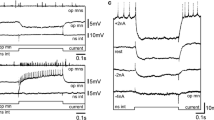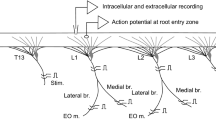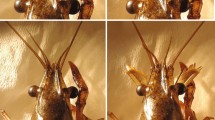Summary
-
1.
Intracellular recordings from neuronal somata and extracellular recordings from peripheral nerves were used to study the effects of impulses in the giant escape command interneurons upon the extensor systems in the crayfish abdomen.
-
2.
Extensor motoneurons are inhibited by command cell impulses. Inhibitory postsynaptic potentials (IPSPs) occur in the phasic motoneurons at short latency and last for 20–30 ms. IPSPs also occur, but less reliably, following antidromic stimulation of the fast flexor motoneurons (Figs. 1, 2).
-
3.
The peripheral inhibitors to both the phasic and tonic extensor muscles are excited by command cell impulses; a single command cell impulse can produce a burst of impulses in the inhibitors (Figs. 3–5).
-
4.
The largest ‘accessory’ neuron or peripheral inhibitor of the muscle receptor organ (MRO) is also excited by the escape command cells (Fig. 6).
-
5.
The durations of IPSPs in the phasic extensor motoneurons, MROs, and phasic extensor muscles are all less than half as long as IPSPs in flexor elements. Thus, they are short enough to permit the extensors to be activated at the termination of the flexion phase (Fig. 7).
-
6.
No evidence was obtained in isolated cords for rebound from inhibition or delayed excitation of extensor motoneurons. The exclusive effect of a command impulse upon the extensor systems is inhibition. Inhibition occurs centrally, and peripherally at sensory elements and muscles.
Similar content being viewed by others
References
Eckert, R.O.: Reflex relationships of the abdominal stretch receptors of the crayfish. I. Feedback inhibition of the receptors. J. cell. comp. Physiol.57, 149–162 (1961 a)
Eckert, R.O.: Reflex relationships of the abdominal stretch receptors of the crayfish. II. Stretch receptor involvement during the swimming reflex. J. cell. comp. Physiol.57, 163–174 (1961 b)
Fields, H.L.: Proprioceptive control of posture in crayfish abdomen. J. exp. Biol.44, 455–468 (1966)
Fields, H.L., Kennedy, D.: Functional role of muscle receptor organs in crayfish. Nature106, 1232–1237 (1965)
Furshpan, E.J., Potter, D.D.: Transmission at the giant motor synapses of the crayfish. J. Physiol.145, 289–325 (1959)
Kennedy, D., Calabrese, R., Wine, J.J.: Presynaptic inhibition: Primary afferent depolarization in crayfish neurons. Science186, 451–454 (1974)
Kennedy, D., Evoy, W.H., Fields, H.L.: The unit basis of some crustacean reflexes. Symp. Soc. exp. Biol.20, 75–109 (1966)
Krasne, F.B., Bryan, J.S.: Habituation: Regulation through presynaptic inhibition. Science182, 590–592 (1973)
Krasne, F.B., Wine, J.J., Kramer, A.: The control of crayfish escape behavior. In: Identified neurons and behavior of arthropods (ed. G. Hoyle). New York: Plenum, in press
Kuffler, S.W., Eyzaguirre, C.: Synaptic inhibition in an isolated nerve cell. J. gen. Physiol.39, 155–185 (1955)
Larimer, J.R., Eggleston, A.C., Masukawa, L.M., Kennedy, D.: The different connections and motor outputs of lateral and medial giant fibres in the crayfish. J. exp. Biol.54, 391–402 (1971)
Mittenthal, J.E., Wine, J.J.: Connectivity patterns of crayfish giant interneurons: Visualization of synaptic regions with cobalt dye. Science179, 182–184 (1973)
Mulloney, B., Selverston, A.: Antidromic action potentials fail to demonstrate known interactions between neurons. Science177, 69–72 (1972)
Otsuka, M., Kravitz, E.A., Potter, D.D.: Physiological and chemical architecture of a lobster ganglion with particular reference to gamma-amino butyrate and glutamate. J. Neurophysiol.30, 725–752 (1967)
Parnas, I., Atwood, H.L.: Phasic and tonic neuromuscular systems in the abdominal extensor muscles of the crayfish and rock lobster. Comp. Biochem. Physiol.18, 701–723 (1966)
Roberts, A.: Recurrent inhibition in the giant-fibre system of the crayfish and its effect on the excitability of the escape response. J. exp. Biol.48, 545–567 (1968a)
Roberts, A.: Some features of the central co-ordination of a fast movement in the crayfish. J. exp. Biol.49, 645–656 (1968 b)
Selverston, A.I., Remler, M.P.: Neural geometry and activation of crayfish fast flexor motoneurons. J. Neurophysiol.35, 797–814 (1972)
Takeda, K., Kennedy, D.: Soma potentials and modes of activation of crayfish motoneurons. J. cell. comp. Physiol.64, 165–182 (1964)
Treistman, S.N., Remler, M.P.: Extensor motor neurons of the crayfish abdomen. J. comp. Physiol.100, 85–100 (1975)
Wiersma, C.A.G.: Giant nerve fiber system of the crayfish. A contribution to comparative physiology of synapse. J. Neurophysiol.10, 23–38 (1947)
Wiersma, C.A.G.: Repetitive discharges of motor fibers caused by a single impulse in giant fibers of the crayfish. J. cell. comp. Physiol.40, 399–419 (1952)
Wine, J.J.: Crayfish neurons with electrogenic cell bodies: correlations with function and dendrite properties. Brain Res.85, 92–98 (1975)
Wine, J.J.: Crayfish escape behavior. III. Monosynaptic and polysynaptic sensory pathways involved in phasic extension. J. comp. Physiol.121, 187–203 (1977a)
Wine, J.J.: Neuronal organization of crayfish escape behavior: inhibition of the giant motoneuron via a disynaptic pathway from other motoneurons. J. Neurophysiol., in press (1977b)
Wine, J.J., Hagiwara, G.: Crayfish escape behavior. I. The structure of efferent and afferent neurons involved in abdominal extension. J. comp. Physiol.121, 145–172 (1977)
Wine, J.J., Hagiwara, G.: Durations of unitary synaptic potentials help time a behavioral sequence. Science, in press
Wine, J.J., Mistick, D.: The temporal organization of crayfish escape behavior: Delayed recruitment of peripheral inhibition. J. Neurophysiol.40, 904–925 (1977)
Zucker, R.S.: Crayfish escape behavior and central synapses. I. Neural circuit exciting lateral giant fiber. J. Neurophysiol.35, 599–620 (1972a)
Zucker, R.S.: Crayfish escape behavior and central synapses. III. Electrical junctions and dendrite spikes in fast flexor motoneurons. J. Neurophysiol.35, 638–651 (1972b)
Author information
Authors and Affiliations
Additional information
Supported by N.S.F. Grant BNS 75-17826. I thank G. Hagiwara for technical assistance and criticism of the manuscript, and Cecilia Bahlman for preparation of the manuscript.
Rights and permissions
About this article
Cite this article
Wine, J.J. Crayfish escape behavior. J. Comp. Physiol. 121, 173–186 (1977). https://doi.org/10.1007/BF00609610
Received:
Issue Date:
DOI: https://doi.org/10.1007/BF00609610




